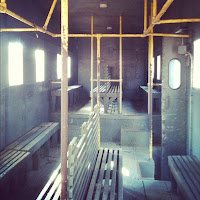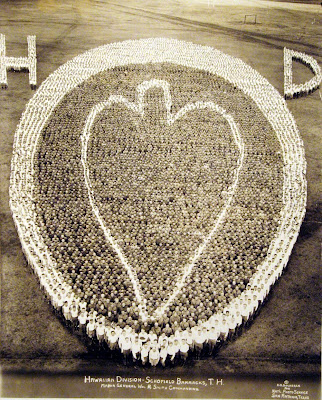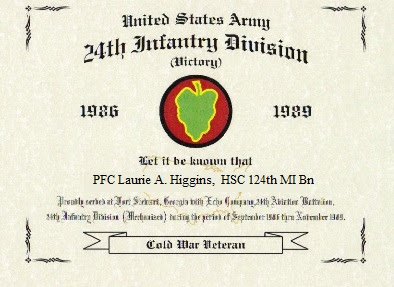He then welcomed us to the Army and to the reception battalion. He explained that we would be there for several days and would be in processing, getting shots, getting our uniforms etc. After this yelled on your feet and we all stood up as one. You learn quick. They led us out of the auditorium and down a hall to a room that had another small room with two doors on either side. They made us dump out our bags and went through everything and proceeded to tell us everything we would not be allowed to have. It ran the gamut from porn to weapons, to booze, smokes or even Tylenol. The little room turned out to be the amnesty room, it contained a trash can and we all went in single file and if we had anything that was not allowed, if we put it in the trash can we would not get in trouble, if we were found with it later we would get in serious trouble. I waited my turn, went in, closed the door, looked at the trash can and wondered if anybody had put anything in there, then walked out the other side.
After that they led us to the barracks and told us to get a bed and put our stuff in a wall locker, which we did. It was pretty close to midnight now and they finally led us to chow. I don't remember what I ate, it was probably a veal patty since the Army is in love with them, but I remember it being good what ever it was. We sat there and ate, very quickly and quietly.
Next we went back to the barracks and they told us to make our beds, but didn't show us how, not the military way, then shower and go to bed, lights out would be in an hour.
I had always been very shy about allowing anybody to see me naked. I remember when I was a kid I went swimming with my aunt at the lake and they had bath houses and everybody just took their clothes off and put on their suits, I was mortified. I didn't let my mom see me naked after puberty hit. I just didn't do it. I suddenly realized that I had never given any thought to having to dress and undress in front of other people. I told myself that it would be like when you go camping so I went to go look at the shower stalls. HA! It was a huge shower with tile walls and floor and 3 rows of shower heads sticking out of the wall, my heart sank. Everybody was just standing in there naked showering and not seeming to care that everybody else was butt naked. I went back to my locker and proceeded to fart around for about 30 minutes, digging in my bags getting my shower stuff and trying to work out what I was going to do.
By the time I made it back to the shower almost everybody was out and there were only two people left showering so I fumbled around in my shower kit getting my soap and shampoo out until the coast was clear and I was alone. I quickly undressed and got under the first shower as quick as I could hopping that nobody else came. They didn't, I was the very last one. I got under the water, picked up my bar of soap, ran it down my right arm, and immediately dropped it and it went directly down the drain, which had it's brass cover removed, like you always do with anything that needs to be shined daily when you are in the Army, you put it back during they day and take them all out when you are going to use them. I later learned that this also happens with shower curtains and anything that that has to be cleaned. So I washed with my shampoo, it was a bottle of Silkience as I recall, my bar of soap that I brought was Coast and I never got to use it. I remember spending time deciding what shampoo and soap I wanted to get for when I left. It seemed important to me at the time that I get the exact right ones. I remember later I switched to Prell shampoo in the tube because I remembered that my dad always had that in his shave kit when he was in the Air Force. They stopped putting it in tubes so I don't use it anymore, but if they did I would. I'm that sad.
I finished my shower as fast as I could, I'm pretty sure it was under 2 minutes, and by the time I got back everyone was already in bed. The Drill Sergeant came told us it was lights out and to get some sleep, in a very stern manner, because we were getting up at 0500. It was about 2:30am,5 minutes later, or so it felt, the lights came back on and a different Drill Sergeant was screaming at us to get up, get dressed and get outside in the ASAP.
The first thing they did was teach us to march, kind of, it was enough to get us from point A to point B as a group, the second thing they did was take us to get paid and to the PX to buy the stuff we needed that we didn't bring. I remember buying a brand new pair of tennis shoes. I had brought everything on the list with me even my shoes so there was not much I needed to buy. Shoe polish, some extra brown towels and bath cloths and a brand new pair of Nikes. It was the first pair I ever owned. I saw them there on the rack and everybody seemed to be buying tennis shoes. I had brought my old pair because I thought they were fine, but damn, NIKE tennis shoes and me with a wad of cash in my hand. They only had two styles to choose from. I got the tan. To this day I only buy Nike tennis shoes. Yeah, its like that, and that's the way it is.
Things I remember about receiving...
Being told to guard our money, people would steal it. The next day I remember a girl sitting on some bleachers crying because her money had been stolen.
Getting shots, with a gun and somebody passing out.
Waiting in line, as close as we could stand to the person in front of us, at parade rest, with our right foot against the wall. This would be the way that was done for the entire time we were in basic.
Filling out my financial paperwork and who would get what if I got deployed and died.
Filling out my SGLI insurance $50,000.
Going down the line with my duffle bag open having my gear issued to me with them tossing it in the bag one item at a time. My uniform size was small/extra short.
Trying on my boots.
Sitting on those benches and waiting to get my picture taken in that fake class A uniform and old style beret that females wore back then. I remember the Drill Sergent leading us around that day said we were getting pictures taken if we wanted to put on make up go in the latrine and do it now. 1 minute later he yelled for them to all get back out they were done with make up. I had stayed in my seat and thought that humorous.
The day the REAL Drill Sergeants showed up, dressed in class A uniforms, with two cattle cars pulled by diesel trucks, all full of hell and fire, to take us to basic training.
 They had sent Drill Sergeant Cunningham and Drill Sergeant Smalls, by far, we would learn, the meanest looking and and acting Drill Sergeants there. They had us all stand in a line with our duffle bags at our feet. They said to pull out our dog tags and our ID and they came down the line and checked our names and Cunningham pause when he got to me and said "Don't be scared private, you don't have anything to be scared about, yet." I thought to myself, but I'm not scared, did he think I was shaking or something? I just stood there and he quickly moved along. They then screamed at us that on their command we would pick up our bags and get in the cattle cars as quickly as we could, which we did. The doors closed and the truck began to pull away.
They had sent Drill Sergeant Cunningham and Drill Sergeant Smalls, by far, we would learn, the meanest looking and and acting Drill Sergeants there. They had us all stand in a line with our duffle bags at our feet. They said to pull out our dog tags and our ID and they came down the line and checked our names and Cunningham pause when he got to me and said "Don't be scared private, you don't have anything to be scared about, yet." I thought to myself, but I'm not scared, did he think I was shaking or something? I just stood there and he quickly moved along. They then screamed at us that on their command we would pick up our bags and get in the cattle cars as quickly as we could, which we did. The doors closed and the truck began to pull away. 
The cattle car had two rows of benches all the way around and tiny rectangular windows all they way up at the top where you couldn't see out of them. Drill Sergeant Cunningham got on and stood right in front of me and screamed for nobody say anything and not to look at him that he better not catch anybody looking at him so we spent the rest of the trip, not knowing where we were going and staring blankly off in different directions so that we didn't accidentally look at Drill Sergeant Cunningham.






